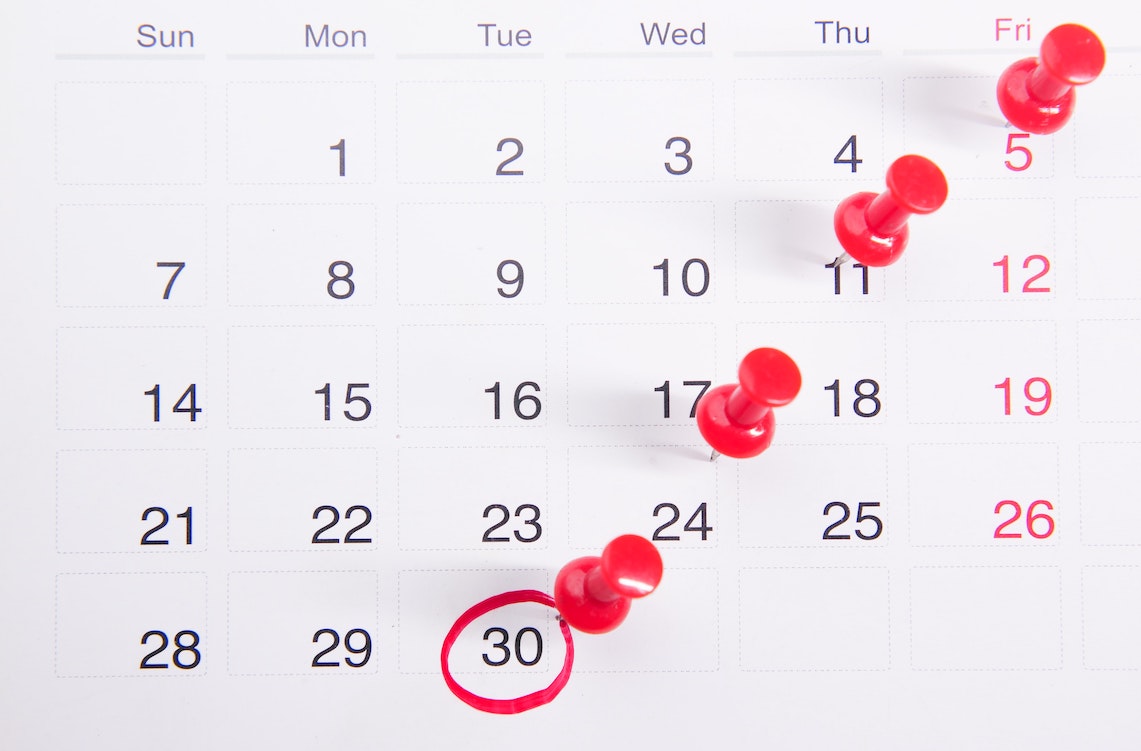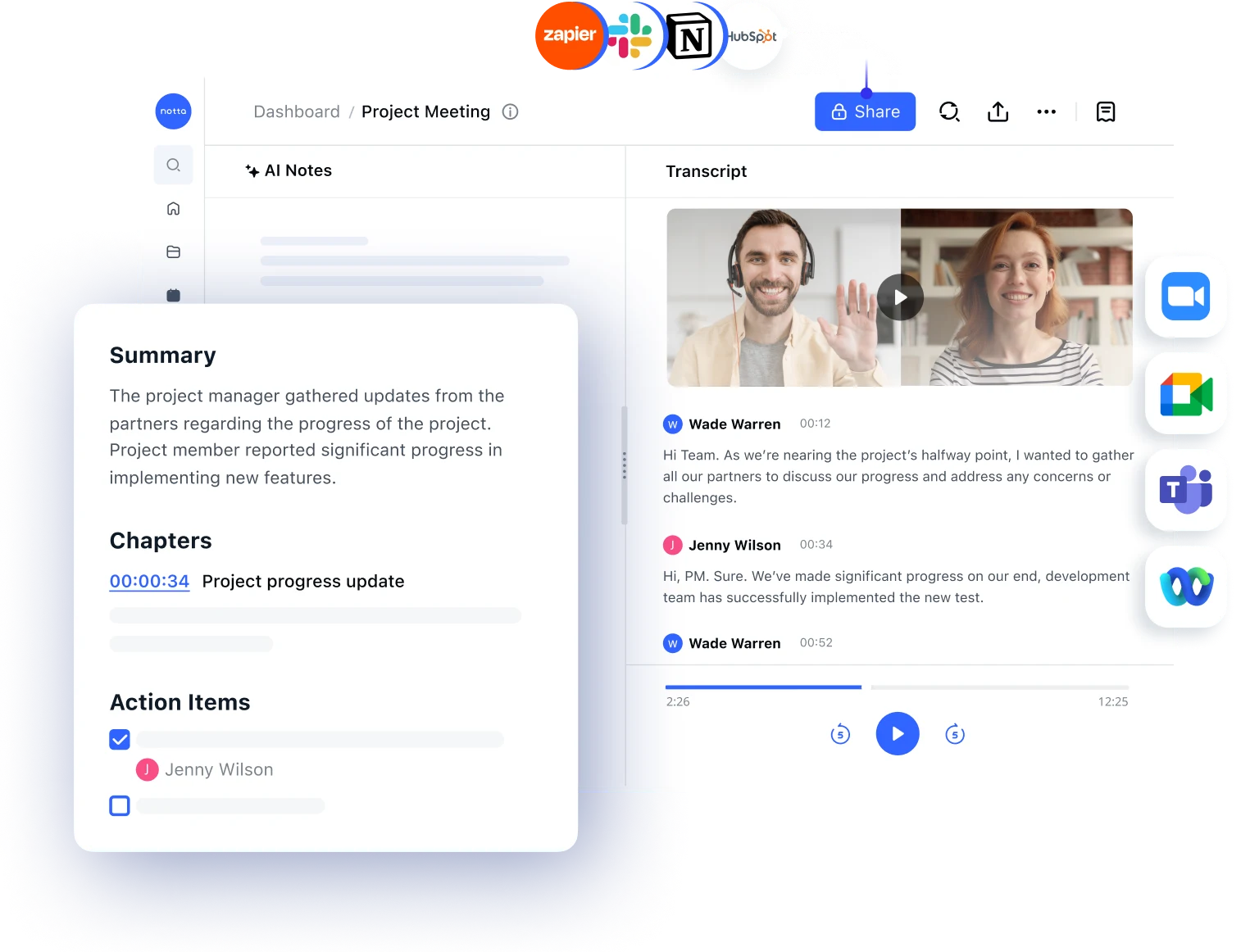
Meeting Cadence Guide: Striking the Right Balance for Your Team
Unlock the power of AI — Notta's meeting assistant records, transcribes and summarizes meeting minutes with one click.
Have you ever gotten to work with fresh hopes of ticking off your entire to-do list, only to find out that there are a lot of meetings scheduled for that particular day? According to the latest meeting statistics, 83% of employees spend up to one-third of their workweek in meetings.
Too many meetings can hamper a person’s productivity, therefore, setting an effective meeting cadence is essential for the success of an organization’s operations.
Every organization should strike a balance so that employees have ample time to work on deliverables and still show up at important team meetings.
Not sure what to do? In this article, we’ve explained the concept of meeting cadence, how to choose the right one for your team, and finally, tips on how to improve the productivity of meetings.
What is a meeting cadence?
Simply put, meeting cadence refers to the frequency and regularity of meetings held within a team or organization. How often does your team meet within a given period? What is the frequency of your recurring meetings? Do you meet every day, once a week, or once in two weeks? The answer to these questions projects what meeting cadence entails.
Some people misconstrue meeting cadence to mean the pace at which a meeting takes. But this is far from the idea. While a meeting’s pace is the speed with which the meeting goes, meeting cadence is basically a pattern in which teams organize meetings.
It’s advisable for teams and organizations to adopt a meeting cadence that every member will be aware of, instead of setting spontaneous meetings. Adopting a meeting pattern creates an established structure. With a structure in place, team members can easily organize their days and weeks to accommodate meetings while still meeting deadlines on other important tasks.
What does meeting cadence really look like? Let’s briefly examine examples for context. If a team meets once a week, perhaps every Friday, that’s a weekly meeting cadence. A bi-weekly cadence meeting is when a team or an organization holds meetings once in two weeks. The monthly meeting cadence connotes that the meetings are held once every month. If the meeting is held once every quarter, then it is a quarterly meeting cadence.
Meeting cadence for different types of meetings
Generally, there are different types of meetings that teams and organizations hold regularly. Each of these meetings has its peculiarities. A one-on-one meeting is clearly distinct from a sales or pitch meeting.
Given these apparent distinctions, there are meeting cadences that suit a specific meeting type more than another. Having this in mind will help you choose the right meeting cadence for your meetings. But before we delve into how to choose the right meeting cadence, let’s have a look at some meeting types and meeting cadences that are appropriate for them.
1. Quarterly Business Reviews
Otherwise known as QBR, this meeting type is an effective way for teams to review their quarterly goals and achievements.
A quarterly business review(QBR) can be held internally or done with customers and prospective customers of the business. When done internally, its purpose is to review team or department performance and set new goals. On the other hand, it is used as a medium to advertise their business and share its successes when customers and prospective customers are involved.
As the name implies, QBRs are held quarterly, which means they employ a quarterly meeting cadence. This means that the team will meet a total of four times a year.
The standard approach is for the meeting to be scheduled for the end of the quarter. Following this approach, your team will have its QBRs held in March, June, September, and December.
2. Sales Meetings
A sales meeting refers to a meeting scheduled by the sales team or department of an organization. It usually involves members of the sales department, top executives within the organization, developers, manufacturers, clients, and prospective clients.
Sales meetings may be aimed at motivating employees, setting department goals, identifying challenges in the department, discussing new products and services, and providing both new and existing clients with knowledge of the company and its products, as well as the benefits they stand to gain.
What type of meeting cadence is suitable for this kind of meeting? First of all, a sales team can have daily meetings, sometimes called daily stand-ups. Daily stand-ups are usually very short, say about 5 - 10 minutes. And they’re usually held at the start of the day. Here, team members share what they’re currently working on and any challenges they might be facing.
Sales meetings can also be held weekly, monthly, or quarterly, depending on the organization’s size, line of work, and goals.
3. One-on-Ones
This type is simply a meeting between two members of a team. They are usually more personal than other types of meetings. There are different variants, such as general one-on-ones with direct reports, skip-level meetings, and peer one-on-ones.
Organizations utilize one-on-one meetings for a variety of reasons which include:
Understanding how team members feel about the organization and their job
Uncovering any excesses in leadership and management
Identifying challenges and areas of improvement
Developing rapport and fostering team bonding
What should a meeting cadence for one-on-ones be like? Regular one-on-ones can be scheduled weekly or bi-weekly. Skip-level meetings are meetings between a top executive in an organization and a direct report, thus they are held sparingly. They can be held quarterly or once in a year.
4. Agile Meetings
Agile meetings are variants of a project management methodology called the scrum framework. We’re not focused on project management, so I won’t be going into the details.
But, it basically refers to meetings held by members of a team whereby they gather to hyper-focus on a particular task, making constant improvements till the desired outcome is achieved.
The meeting cadence for agile meetings is usually flexible. It can be weekly, bi-weekly, or monthly.
Notta offers the most integrated AI meeting notes, summaries, and action items so nothing gets missed.
How to choose the right meeting cadence
Determining the appropriate meeting cadence for meetings should be a priority for teams and organizations. Too many meetings can hamper productivity, while fewer meetings may create a gap in team collaboration. Therefore, it is necessary for teams to find healthy dynamics.
Choosing the right cadence shouldn’t be a hassle. Here’s how you can go about it:
1. Consider the nature of the project
What is the nature of the project your team is currently working on? Does it require frequent exchange of information? Does your team need frequent discussions to deliver efficiently on the project? Will a particular meeting pattern disrupt the productivity of the team?
Ask yourself these questions and provide honest answers to them. Doing so can help you decide how frequent your meetings should be or if you even need any meetings at all.
2. Factor in your team size
Taking into consideration the size of your team can be useful in helping you choose an appropriate cadence. It’s easier for small teams to collaborate on a project effectively without needing to meet many times.
A relatively large team, on the other hand, might have to gather together from time to time to share ideas, evaluate team progress, identify challenges, and proffer solutions. Without frequent meetings, interaction between the team may be low, and this might not be good for the project or the team itself.
3. Try different approaches
Don’t be afraid to make mistakes. Sometimes, you might not be able to determine which cadence is best for the team without first testing a number of them.
For instance, if you realize that daily stand-ups don't cut it for your team, try meeting weekly or bi-weekly to see if that suits the team better. If weekly or bi-weekly meetings don’t feel right, consider using a monthly cadence. Eventually, you’ll find the approach that is most befitting.
4. Get ideas from your team
Some team members may be finding it difficult to cope with the daily stand-ups or weekly meetings, yet stay mute about it. Perhaps not to come off as lazy or less committed. But deep down, they know meeting every day is pointless and only a waste of time that could’ve been expended on something more important.
So, it’s best to always interact with your team to get their ideas on how often meetings should be. Once a consensus is reached, you can be sure that the majority is comfortable with the meeting schedule.
Pro tips for having effective meetings
Now you know how to find the perfect meeting cadence for your team, here are some additional tips to superpower your meetings.
1. Always have an agenda
Always ensure to have an agenda for the meetings. Don’t set up a meeting without having any cogent issues to discuss. That would be a sheer waste of time and if it becomes a habit, can be counter-productive to team performance.
If you’re setting a meeting only to follow an established pattern, then you should cancel it. Where there is a new agenda for the recurring meeting, share it with the team prior to the meeting, so that attendees will be able to preview it and contribute meaningfully at the meeting.
2. Invite only relevant members
A recurring meeting could have an agenda that doesn’t concern some members from the previous meeting. In such a case, there’s no need to invite them to the recurring meeting.
Better still, let them know that their participation is not required and it is optional for them to attend. This allows them the freedom to decline meetings to focus on other important tasks.
3. Use Notta to take automated notes for your meetings
Taking notes helps you commit things to memory. By doing so, you will be able to highlight the key points discussed during the meetings which can be a point of reference for subsequent meetings.
Nevertheless, do you feel overwhelmed when you are trying to engage in the conversation and take notes simultaneously? Well, the Notta AI note-taker is your rescue.
This tool will record meetings online and in-office and generate an accurate transcript automatically, so you can focus on the conversion knowing that there are detailed meeting notes.

The best part is that when the meeting is over, you can review, edit, and share the transcript, making every meeting worthwhile.